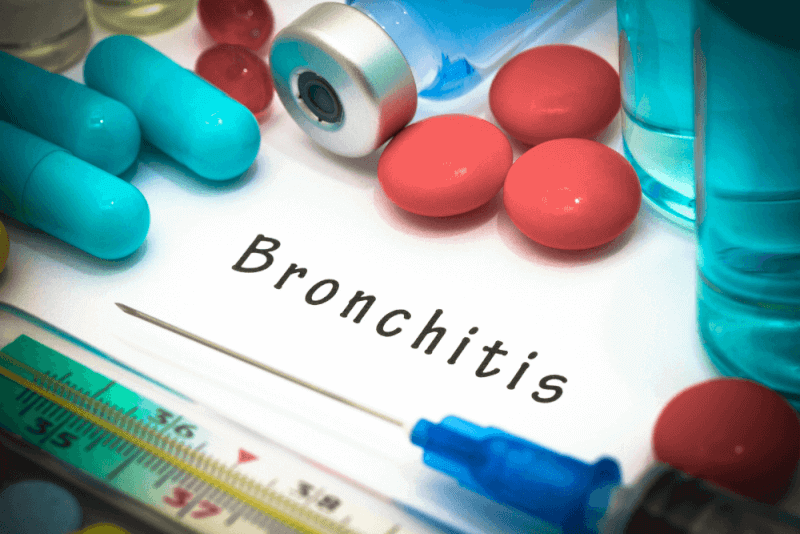30 Second Summary
- Symptoms of bronchitis include cough, phlegm, shortness of breath and chest pain.
- Treatment is usually aimed at alleviating symptoms.
- Antibiotic treatment is only necessary if bronchitis is caused by a bacterial infection.
- Chronic bronchitis is a long-term condition caused by factors such as smoking, air pollution and allergies.
What is Bronchitis?
They are wide and medium-width air ducts that allow the air taken in through the respiratory tract from the bronchi where bronchitis occurs to reach the alveolar sacs, where it meets the blood. Bronchitis is an infection of these air passages due to some factors. Because of this infection, the mucous membrane lining the inside of the bronchi thickens due to edema. In addition, mucus starts to be produced more. As a result of these changes, air cannot reach the alveolar sacs easily.
There are two different types of bronchitis. The first of these is acute bronchitis. Acute bronchitis is an infection caused by bacteria and viruses. Various allergies also play a role in the development of acute bronchitis. It gets better when the causative agent of the infection is treated or when contact with the allergen is stopped.
The other type of bronchitis is chronic bronchitis. It occurs as a consequence of COPD and smoking. Chronic bronchitis is characterized by thickening of the bronchial walls and increased mucus production and does not heal as quickly as chronic bronchitis.
Symptoms of Bronchitis
The most characteristic symptoms of both acute and chronic bronchitis are a deep cough with phlegm and shortness of breath and wheezing. In addition, the following symptoms are also observed in patients.
- Shortness of breath when exercising or moving,
- Feeling tired all the time,
- Cyanosis caused by low oxygen levels,
- Symptoms such as recurrent lung infections are often symptoms of chronic bronchitis.
- Nasal congestion
- Sore throat
- Headache
- Fire,
- Symptoms such as yellow or green sputum are symptoms of acute bronchitis.
Types of Bronchitis
Bronchitis, one of the lung diseases, is divided into various groups.
Acute bronchitis
Acute bronchitis, which usually occurs in children under 2 years of age, is the most common disease among lower respiratory diseases. Acute bronchitis, which causes symptoms like flu and colds, is a viral disease. Acute bronchitis, which is more common than chronic bronchitis, improves within 10 days if treated.
Chronic bronchitis
COPD is a disease seen before COPD in long-term smokers. The biggest difference that distinguishes chronic bronchitis from acute bronchitis is the presence of cough and sputum for 3 months in winter. Chronic bronchitis does not develop due to infection. It is therefore not contagious. But because it is life-threatening, it needs to be treated and treatment can take a long time.
Causes of Bronchitis
The causes of acute and chronic bronchitis are different. The most common cause of acute bronchitis is various viruses. Although not all viruses that cause bronchitis can be identified, the most common ones are rhinovirus, coronavirus, RSV, influenza A and B viruses.
Partial causes of acute bronchitis include bacteria. The most common bacteria causing acute bronchitis are chlamydia, mycoplasma, streptococcus pneumoniae, haemophilus and moraxella catarrhalis.
In addition to these factors, air pollution, exposure to cigarette smoke and allergies can be among the causes of acute bronchitis.
The causes of chronic bronchitis are usually environmental factors and smoking. Smoking, the most common cause, is seen in almost all smokers. Environmental factors include air pollution, dust and constant exposure to chemicals.
How is Bronchitis Diagnosed?
After listening to the patient's history and complaints, specialists perform a physical examination. Acute bronchitis usually occurs after a severe upper respiratory illness. A severe cough with phlegm after an URTI is usually considered the most prominent symptom.
Chronic bronchitis has nothing to do with upper respiratory tract diseases. Chronic bronchitis is considered in a patient with a long history of cough. However, some diagnostic methods are used to rule out other causes.
Blood Tests
Blood tests are important to determine whether there is an infection in the body.
Sputum Tests
Sputum tests are used to identify bacteria and other characteristics that may be present.
Spirometer
This test determines the extent to which patients' bronchial tubes are narrowed. The test measures the amount and velocity of exhaled air. It is especially important to identify comorbidities such as asthma or COPD.
Arterial Blood Gas
It is a test to determine the oxygen and carbon dioxide in the blood. The acidity level of the blood is also measured. Although it is a test that is not always performed, it is used to determine the severity of bronchitis in patients and to determine the status of diseases such as COPD.
Chest X-ray
It is performed to detect both pneumonia and airway obstruction.
CT Scan
is another method used to visualize obstructions that may be present in the airways. It also helps to identify mass diseases such as atelectasis.
Bronchitis Treatment
The treatment of bronchitis varies according to the causative agent. Bronchitis is treated by identifying and treating the underlying cause.
Antibiotic Treatment
If the underlying cause of bronchitis is a bacterial infection, antibiotic treatment is used. In viral bronchitis, antibiotic treatment is usually not used. However, it can be used if patients are elderly or have other diseases accompanying bronchitis.
Medication to alleviate symptoms
A number of medicines are used to prevent the formation of the thick mucus that occurs with bronchitis. These medicines also help to relax the airways. It is used for both bacterial and viral bronchitis. It can also be used in some patients with allergies. In order to support the treatment, it is necessary to consume plenty of water.
What is good for bronchitis?
It is recommended to gargle with salt water to relieve the throat of patients with phlegm problems and to remove the infection in this area. For this, two tablespoons of salt should be placed in a glass of water and gargle at regular intervals.
The presence of patients in a dry and humid environment causes their complaints to increase. For this reason, the environment they are in should be moisturized with natural humidification methods.
In order to prevent the bronchioles from narrowing and to remove the residues, it is necessary to drink at least 2 liters of water a day.
Nutrition in Bronchitis
Bronchitis patients can respond more quickly to treatment with the help of certain foods. It is also important for patients to consume plenty of water.
- It should be fed with foods rich in vitamin A. These are found especially in yellow and orange fruits and vegetables.
- Mint helps to reduce the symptoms of bronchitis and helps to open the nose.
- A diet rich in vitamin C is one of the best supports for bronchitis. In addition to citrus fruits, it is recommended to consume red pepper, parsley, kiwi, thyme, dark leafy vegetables.
- Ginseng, one of the protectors of the immune system, is also protective against acute bronchitis.
- Oily fish strengthen the body's immunity to prevent infection and fight germs.
- Green tea is effective in preventing the spread of infections caused by viruses.
What is good for bronchitis cough?
Some natural foods can help relieve the cough caused by bronchitis. These include the following.
Onion
Onion, which is rich in antioxidants, is one of the foods that are good for bronchitis and cough. For this, onion can be consumed raw or a tablespoon of onion juice can be consumed.
Bal
Another food rich in antioxidants is honey. Honey is a food that not only relieves cough but also helps to reduce problems such as phlegm. However, in order to get the best benefits, the highest quality honey possible should be consumed.
Ginger
Ginger can be used alone or mixed with turmeric and honey. It provides relief of both cough and phlegm. Powdered or fresh ginger can be used to relieve the cough caused by bronchitis.
Turmeric
Turmeric, which has effects at least as strong as ginger, plays a role in strengthening the immune system as well as relieving cough. Black pepper can also be added to strengthen the effect of turmeric, which can be consumed with honey or olive oil.
Linden
Linden, which is extremely effective from winter diseases, also provides relief from cough. The effect can be increased by adding honey or ginger.
Mint
Peppermint tea and peppermint oil is a herb that improves bronchial function. In addition, mint oil, which also provides relaxation of the sinuses, is effective in eliminating problems such as cough and phlegm.
Eucalyptus
Eucalyptus, which can be consumed as tea or oil as in mint, shows an effect like mint. It allows bronchitis patients to breathe easily and eliminates problems such as wheezing and coughing.
Vitamin C
Consuming plenty of fruits and vegetables rich in vitamin C also strengthens the immune system. In this way, both cough and sore throat can be cured quickly.
Drink plenty of fluids
The first priority for bronchitis patients is to drink plenty of fluids. For this, water, herbal teas and fruit juices should be consumed.
How to Reduce the Risk of Bronchitis?
To reduce the risk of getting bronchitis, the following points are recommended.
- Stop smoking and avoid exposure to cigarette smoke
- Avoiding factors that cause irritation of the respiratory tract
- If you catch a cold, you should get plenty of rest.
- Establishing a healthy diet
- Frequent hand washing with soap
- Regular flu or pneumonia vaccinations
Is Bronchitis Transmitted?
If bronchitis is caused by microorganisms, it is classified as an infectious disease. Bronchitis caused by causes other than microorganisms is not contagious. Among the causes of bronchitis, viral bronchitis is the most contagious type.
How Many Days Does Bronchitis Go Away?
The recovery process of bronchitis patients varies. For example, acute bronchitis varies within 1 to 3 days. The recovery period for chronic bronchitis is longer. To speed up the healing process, it is recommended to start treatment as soon as possible, take medication regularly and rest.
Bronchitis in Infants
Bronchitis usually occurs in babies under 2 years of age. In some cases, it causes shortness of breath requiring hospitalization. The reason why bronchitis is more common in babies is that the diameter of their bronchi is smaller than in adults. For this reason, they are more easily obstructed and are more frequently affected by viral infections due to their low immunity.
It is especially more common in babies who are not breastfed, born prematurely and exposed to cigarette smoke. In addition, bronchitis is more common in children in environments where the risk of infection is higher, such as day-care centers.
Symptoms of bronchitis in infants
The symptoms of bronchitis in infants are similar to the symptoms of acute bronchitis. Symptoms of bronchitis in infants include the following.
- Dry cough and subsequent phlegm
- Pain in the chest area
- Burning in the chest area
- Light fever
- Tremor
- Sore throat
- Sinus congestion
- Shortness of breath
- Wheezing
- Fatigue
- Runny nose
How to prevent bronchitis in infants and children?
Bronchitis in infants and children is one of the most common diseases. However, it is possible to prevent it. Among the points to be considered for this are the following:
- Balanced and healthy nutrition
- Having a regular sleep pattern
- Personal hygiene
- Gaining the habit of hand washing
- Being in a clean atmosphere
- Staying away from cigarette smoke
- Paying attention to home hygiene














